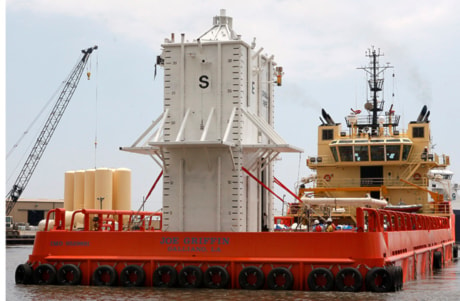NEW ORLEANS — The best short-term solution to bottling up a disastrous oil spill threatening sealife and livelihoods along the Gulf Coast should be headed out to sea Wednesday in the form of a specially built giant concrete-and-steel box designed to siphon the oil away.
At about midday, a barge will haul the huge contraption 80 kilometres offshore to a spot where a gusher from a blown-out undersea well has been spewing nearly 800,000 litres of crude a day into the Gulf for two weeks. British Petroleum spokesman John Curry said it would be deployed on the seabed by Thursday.
It’s the latest idea BP engineers are trying after an oil rig the company was operating exploded April 20, killing 11 workers. It sank two days later.
BP is in charge of the cleanup and President Barack Obama and many others have said the company also is responsible for the costs.
BP capped one of three leaks at the well Tuesday night, a step that will not cut the flow of oil but that BP has said will make it easier to help with the gusher.
“It doesn’t lessen the flow, it just simplifies the number of leak points they have to address,” Coast Guard Petty Officer 1st Class David Mosley said.
The capped leak was some 250 metres from the blowout preventer, which sits over the well head on the seafloor.
Most of the oil is coming from a leak about 150 metres feet from the preventer, while a smaller leak is still allowing oil to escape from a crack where the pipe casing bent about two metres from the top of the preventer.
Meanwhile, the effort to protect Louisiana coastal wetlands was expected to pick up.
In Plaquemines Parish, officials loaded absorbent boom shortly after dawn to take out to the mouth of the Mississippi River. The barge will be used as a distribution point for local fishermen to lay the boom around sensitive marshes.
Parish president Billy Nungesser said the parish has 40 kilometres of the boom. Workers in yellow rain suits scrubbed air boats. At a nearby marina, local shrimpers planned to use their boats to put down boom as part of a program BP is running.
In all, about 7,900 people are working to protect the shoreline and wildlife, and some 170 boats are also helping with the cleanup.
A rainbow sheen of oil has reached land in parts of Louisiana, but forecasts showed the oil wasn’t expected to come ashore for at least a couple more days.
“It’s a gift of a little bit of time. I’m not resting,” U.S. Coast Guard Rear Admiral Mary Landry said.
In their worst-case scenario, BP executives told members of a congressional committee that up to 9.5 million litres a day could spill if the leaks worsened, though it would be more like 6.4 million litres. In an exploration plan filed with the government in February 2009, BP said it could handle a “worst-case scenario” it described as a leak of 25.7 million litres per day from an uncontrolled blowout.
Containment boxes have never been tried at this depth — about 1.5 kilometres — because of the extreme water pressure. If all goes well, the contraption could be fired up early next week to start funnelling the oil into a tanker.
“We don’t know for sure” whether the equipment will work, said BP spokesman Bill Salvin. “What we do know is that we have done extensive engineering and modelling and we believe this gives us the best chance to contain the oil, and that’s very important to us.”
The seas calmed Tuesday, allowing more conventional methods to contain the spill to get back on track as businesses and residents kept an eye on the ocean currents, wondering when the sheen washing ashore in places might turn into a heavier coating of oil. Crews put out more containment equipment and repaired some booms damaged in rough weather over the weekend. They also hoped to again try to burn some of the oil on the water’s surface, possibly Wednesday.
